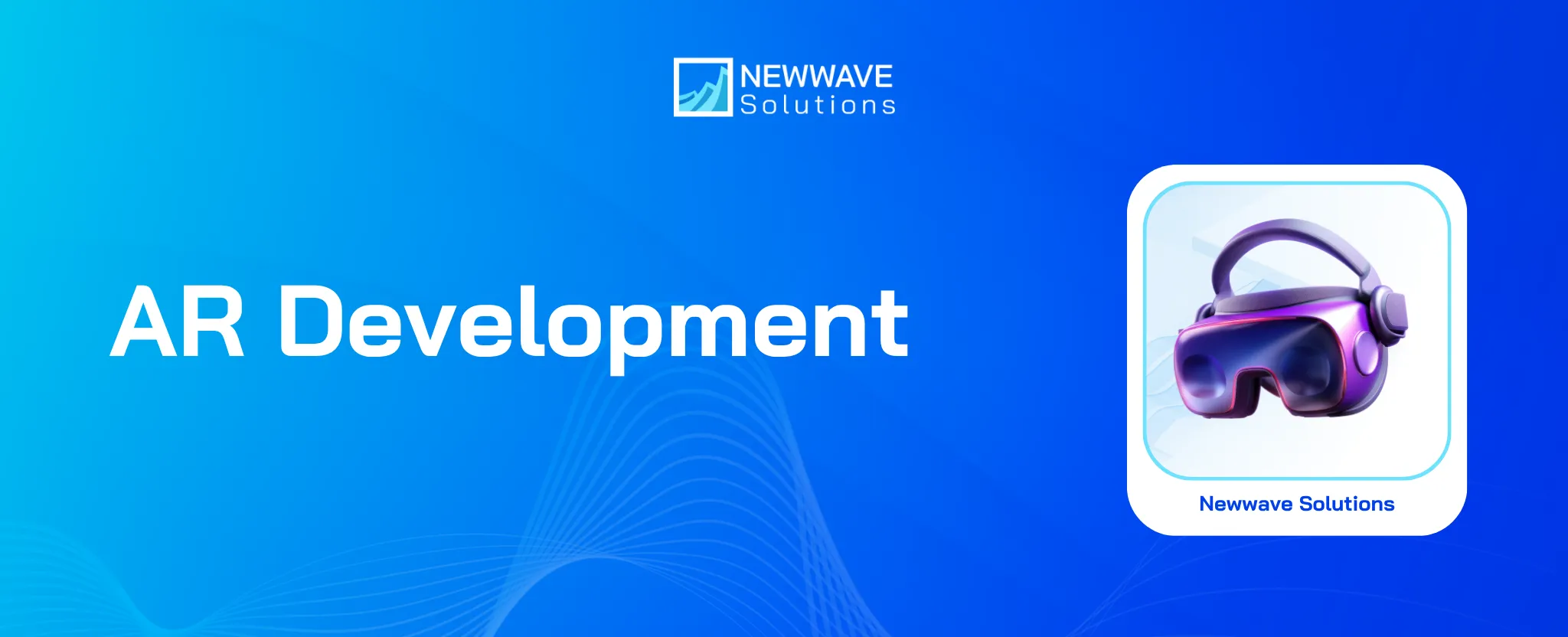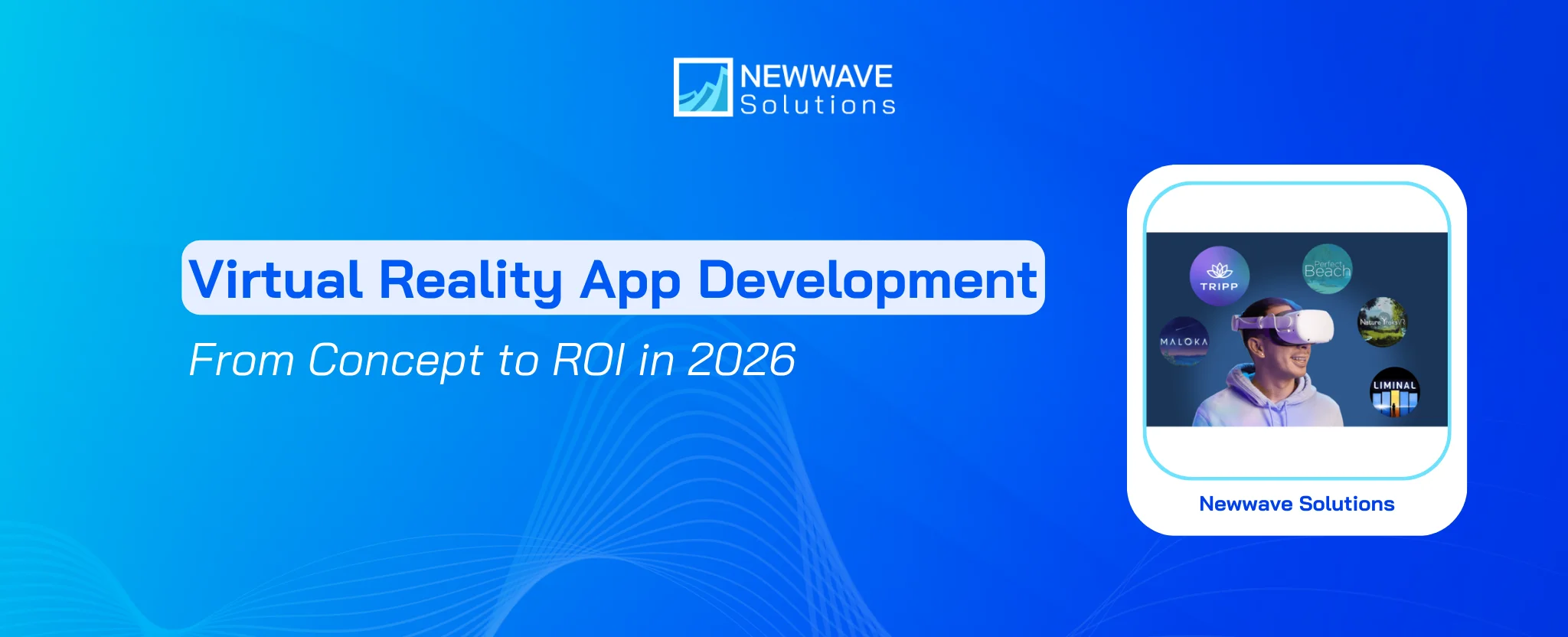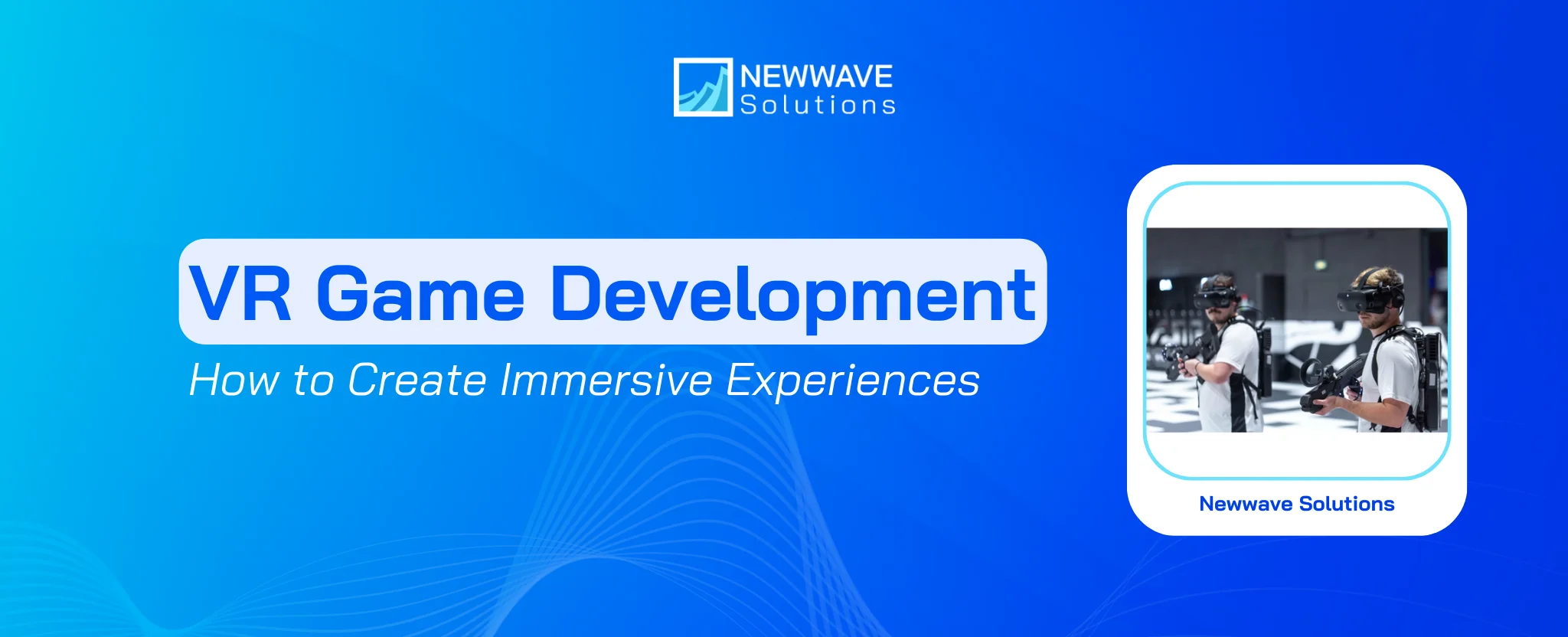What is AR Development? Type, Process and Business Value

When people don’t clearly see a product’s value, opportunities are lost, and competitors using immersive digital experiences are already pulling ahead. These shifts are not a distant possibility — they are actively reshaping markets today. According to Grand View Research, the global AR software market was valued at USD 83.65 billion in 2024 and is projected to reach USD 599.6 billion by 2030. AR development is no longer experimental. This article explores how AR works, the development process, industry applications, and how organizations can capture its long-term value.
What is AR Development?
AR (Augmented Reality) is looking at the real world through your smartphone’s camera, but with a digital layer added on top. Unlike Virtual Reality (VR), which creates a completely digital world you immerse yourself in, AR augments your existing reality. It puts useful digital information—like 3D models, text, or instructions—right into your surroundings, making it feel like these digital objects are part of your physical space. A simple example for AR is a Snapchat filter that adds puppy ears to your head or the popular game Pokémon GO, where digital creatures appear in your real-world park or street.
If AR is the experience of seeing digital things in your real world, AR Development is the technical craft of building that experience. AR Development is the process of building the apps and experiences that make augmented reality possible. It’s the work of software developers who create the “magic” that allows your device to understand the world and place digital content into it seamlessly. They don’t just create the 3D object (like a virtual couch), they write the code that lets your phone’s camera recognize your floor, understand where the ground is, and anchor that virtual couch to a specific spot so you can walk around it.
This involves:
- Using device hardware: Programming the app to use the camera to see the world and the sensors (like the gyroscope and accelerometer) to understand angles and movement.
- Creating the logic: Writing algorithms that can detect flat surfaces like tables and floors, track movement, and understand lighting so the digital object casts a realistic shadow.
- Designing the experience: Ensuring the digital information is helpful, easy to use, and actually solves a problem for the person using it.
What does this look like in practice? Here are a few examples:
- Shopping for your home: An app from a furniture store lets you point your phone at your living room to see how a new virtual sofa would look and fit in the exact space before you buy it.
- Building a skyscraper: Construction engineers on a job site can look through a tablet and see the digital blueprints (like a 3D X-ray view) overlaid perfectly onto the real-life steel beams and concrete in front of them.
- Training a surgeon: Medical students can practice complex procedures using an AR simulator that overlays digital anatomy onto a physical mannequin, providing a risk-free way to gain experience.
The goal of AR development isn’t just to be a cool trick. It’s to connect data to the real world in real-time, helping people make better decisions, understand complex information, and visualize outcomes before they happen.
What is different between AR vs VR?
While often grouped together, Augmented Reality (AR) and Virtual Reality (VR) are distinct technologies with opposite approaches to immersion. The fundamental difference lies in their relationship to the user’s physical environment: VR replaces reality with a digital simulation, while AR enhances reality by adding digital elements to it. This core distinction influences their hardware, applications, and user experience, which are detailed in the comparison table below:
| Aspect | Augmented Reality (AR) | Virtual Reality (VR) |
| Environment | Overlays digital content on the physical world | Fully immerses users in a digital environment |
| Devices | Smartphones, tablets, AR glasses, HMDs | VR headsets (Oculus, HTC Vive, etc.) |
| User Awareness | Users remain aware of surroundings | Users are isolated from physical surroundings |
| Applications | Retail, training, healthcare, manufacturing | Gaming, simulations, virtual training |
| Accessibility | Runs on existing devices like smartphones | Requires dedicated hardware |
| Business Value | Enhances real-world processes and decisions | Creates controlled, immersive experiences |
VR excels in immersive simulations, while AR’s strength lies in augmenting the real world. This makes AR particularly valuable for industries that depend on physical environments, from retail showrooms to operating rooms and construction sites.
Which technologies used in AR Development?

Choosing the right technology is the most critical technical decision in an AR project. There’s no single “best” option; the right choice depends entirely on your project’s goals, target audience, and budget. Think of it like choosing a vehicle: you wouldn’t use a semi-truck for a quick trip to the grocery store, and you wouldn’t use a sports car to haul lumber. The technology should serve the experience you want to create.
Mobile AR
This is how most people experience AR today. By leveraging the cameras, sensors, and processing power of modern smartphones and tablets, developers can create powerful AR apps that are accessible to billions of users worldwide. Mobile AR apps use the device’s camera to see the world. Sophisticated algorithms then analyze the video feed to understand flat surfaces (like floors and tables), track the device’s position in space, and finally, render and anchor digital objects into the live camera view. You interact with the experience by moving your phone or tapping the screen.
Key Technologies be used in & Their Benefits:
Native SDKs (Software Development Kits)
These platform-specific tools provided by Apple and Google. ARKit (for iOS) and ARCore (for Android) are the most powerful options. They offer advanced features like depth sensing (using LiDAR scanners on newer devices), precise motion tracking, and environmental understanding. They provide the highest performance and quality but require building and maintaining two separate apps.
Cross-Platform SDKs
Tools like Unity’s AR Foundation, Vuforia, and Wikitude allow developers to write code once and deploy it to both iOS and Android. This is far more cost-effective and faster for development. The trade-off is that they sometimes lag behind in supporting the very latest device-specific features.
WebAR
This technology allows you to experience AR directly through a web browser without downloading any app. It uses standards like WebXR and platforms like 8th Wall. The huge benefit is instant access—users just click a link and the experience loads. This is perfect for marketing campaigns, simple product try-ons, or viral filters. The main limitation is that browser-based AR can’t yet match the graphical power and complexity of a dedicated native app.
Head-Mounted Displays (HMDs)
Also known as AR glasses or wearables, these devices—like the Microsoft HoloLens, Magic Leap, and Apple Vision Pro—are computers you wear on your head. They have transparent lenses that allow you to see your real environment perfectly, while projectors beam light onto the lenses to create digital holograms that feel fixed in your space. HMDs are designed for complex, hands-free tasks. Instead of holding up a phone, a user’s hands are free to interact with both physical tools and digital interfaces through gestures and voice commands. The digital content is spatially aware, meaning a 3D model of a machine part can be locked to a specific spot on a real-world engine.
Benefits if using for AR Projects: The primary advantage is seamless integration into real-world workflows. For a technician repairing complex machinery, a surgeon planning a procedure, or a designer reviewing a full-scale 3D model, having digital information persistently available in their field of view without looking down at a tablet is transformative. It moves AR from a “cool feature” on a phone to an indispensable professional tool.
Artificial Intelligence in AR
AI and AR are a perfect partnership. While AR provides the canvas, AI acts as the brain that understands what’s on that canvas. AI algorithms are what allow AR apps to make sense of the messy, unpredictable real world. AI is used behind the scenes to power the core functions of AR:
- Object Recognition: An AI model can be trained to identify specific objects, like a piece of industrial equipment or a product on a shelf. The AR app can then overlay the correct instructions or information onto that exact object.
- Scene Understanding: This goes beyond recognizing a single object. AI can analyze an entire room—identifying walls, windows, furniture, and their relationships to each other. This is how an app can realistically place a virtual chair in the corner of your room and have it occluded (hidden) by your real coffee table.
- Gesture and Pose Tracking: AI can understand human body movements. This allows for interaction where a user can control the AR experience with a wave of their hand or for applications in fitness and physical therapy that can track a user’s form.
Benefits if using for AR Projects:
According to PwC, AR and VR combined could contribute USD 1.5 trillion to global GDP by 2030, with training and maintenance among the largest drivers. Integrating AI moves an AR experience from being a simple visualizer to being a contextually intelligent assistant. It allows the experience to be reactive and personalized. For example, an AI-powered AR training guide doesn’t just show generic instructions; it can recognize which step of a process you’re on and which tool you’re holding, providing the right information at the right moment. This dramatically increases the practical utility and value of the AR application.
How many type of AR Application?
AR comes in multiple forms, each designed for different environments and goals. Understanding these categories helps define the right balance between precision, accessibility, and scalability.
| Type | Description | Key Considerations |
| Marker-Based AR | Anchors digital content to predefined images or QR codes. | Reliable and cost-effective but only works if markers are visible. |
| Markerless AR | Detects and tracks surfaces or objects without markers. | Offers flexibility but demands more processing power. |
| Location-Based AR | Uses GPS and sensors to overlay digital content in real-world locations. | Effective for navigation, tourism, and outdoor guides. |
| Projection-Based AR | Projects visuals directly onto physical surfaces. | Useful for industrial design and product demonstrations. |
| Web AR | Runs in browsers without app downloads. | Highly accessible, good for marketing; limited in complexity. |
The best choice depends on project goals – whether the priority is accuracy, accessibility, or speed of adoption.
7 Steps of AR Development
Developing Augmented Reality (AR) solutions isn’t just about getting an app to work — it’s about building a foundation that can scale, adapt, and deliver real business value. Each stage in the process plays a critical role in ensuring long-term success, not just a functional launch:
1. Define the Core Purpose and Goal
Before a single line of code is written, the most crucial question must be answered: Why are we building this? The goal is not to be “cool” but to be useful. This step is about aligning the AR project with a clear business objective or user need.
This involves workshops and discussions to pinpoint the exact problem AR will solve. Will it help customers visualize a product in their home before buying, reducing returns? Will it guide a factory worker through a complex wiring process, cutting errors by 30%? This is where you define Key Performance Indicators (KPIs)—the measurable metrics (like increased sales, reduced training time, or fewer mistakes) that will prove your project’s success. A strong “why” acts as your North Star, guiding every technical and design decision that follows and ensuring the project stays on track to deliver real impact.
2. Choose the Right Technology Foundation
With a goal in hand, the next step is selecting the technological building blocks that will make it possible. This is a strategic decision that affects everything from cost and timeline to who can use the final product.You must architect the solution by making key choices:
- Platform: Will this be a native mobile app (highest performance, using ARKit/ARCore), a cross-platform app (faster development for iOS and Android), or WebAR (accessible via a browser, no app install required)? Each has trade-offs in power, reach, and cost.
- Tracking: How will the device understand its environment? Will it use marker-based tracking (relying on a QR code or image target) for simplicity, or markerless SLAM tracking (using the device’s sensors to map the room) for a more flexible experience?
- Integration: How will the AR experience connect to your existing world? This could mean plugging into an e-commerce platform to pull product models, a learning management system (LMS) to track training progress, or a cloud database in real-time. Planning these connections early is essential for a scalable solution.
3. Design the User Experience for Reality
AR design is not like designing a website or a mobile app. The user’s physical environment is your canvas, and the digital elements must complement it, not complicate it. The core principle is clarity. This phase focuses on how users will interact with the digital layer in their space.
- UI Design: Interfaces must be minimal, contextual, and non-intrusive. Text should be concise, buttons large enough to press easily, and information should appear only when and where it’s needed. The goal is to aid the user, not block their view.
- Spatial Design: This involves deciding how 3D objects behave in the real world. Do they cast shadows? Can they be occluded (hidden) by real objects? This attention to detail is what sells the illusion and makes the experience feel immersive and believable.
- User Testing: This is non-negotiable. You must test prototypes with real users in the actual environments where the app will be used—a busy warehouse, a sunny living room, a dimly lit garage. You quickly learn what works in theory versus what works in practice.
4. Develop and Build the Experience
This is the execution phase where the plan becomes a product. It’s a dual-track process that involves both creating the assets and writing the code that brings them to life. This will include:
- 3D Asset Creation: Artists and modelers source or build the 3D models, animations, and visual effects that users will see. A critical focus here is optimization; models must be detailed enough to look real but lightweight enough to run smoothly on a mobile processor.
- Application Development: Programmers use the chosen technology stack (e.g., Unity with AR Foundation, native Swift for iOS) to integrate the assets, implement the tracking logic, connect to backend systems, and build the app’s functionality. The development focus is on achieving a stable frame rate and a seamless blend between the digital and physical worlds.
5. Rigorously Test in Real-World Conditions
An AR experience that works perfectly in a developer’s office on a high-end phone might fail completely in the field. Rigorous, real-world testing is the only way to ensure reliability and build user trust. Testing must cover a vast matrix of variables:
- Device Fragmentation: Testing on a wide range of devices (old and new phones, different AR glasses) to ensure consistent performance.
- Environmental Factors: Testing under different lighting conditions (bright sun, low light), on various surface textures (patterned carpet, plain concrete), and in different-sized spaces.
- User Flows: Testing every possible interaction path to ensure the app is intuitive and robust, even when used unexpectedly. This step is about finding and fixing bugs before users do.
6. Deploy and Distribute to Your Audience
A brilliant app is useless if no one can get it. The deployment strategy must be tailored to how and where the audience will use the experience. The launch path you choose depends entirely on the project’s goal:
- Public App Stores (Apple App Store, Google Play): Ideal for consumer-facing applications. This requires following platform-specific guidelines and review processes.
- Enterprise Distribution: For internal business tools, using Mobile Device Management (MDM) solutions to securely roll out the app to company-owned devices without going through public app stores.
- WebAR URL: For marketing campaigns, simply share a link. Users open it in their mobile browser for an instant experience with no installation required.
7. Maintain and Evolve for the Long Term
An AR application is not a one-and-done project; it’s a living product. The digital world changes rapidly, and your solution must adapt to remain effective and secure. Post-launch maintenance will include:
- Technical Updates: Operating systems (iOS, Android) and AR SDKs (ARKit, ARCore) are updated frequently. Your app must be tested and updated to maintain compatibility and performance.
- Content Updates: Keeping 3D models, product catalogs, and information current to reflect new offerings or procedures.
- Analytics and Support: Monitoring usage data to understand how people use the app and using that insight to plan new features. Providing support for user issues is key to long-term adoption. This ongoing commitment protects your investment and ensures continuous ROI.
What are AR Development Challenges?
Developing AR applications involves challenges that extend beyond technical implementation. Each obstacle, however, has practical ways to address it:
Hardware limitations
AR performance is directly affected by device processing power, memory, and battery life. Poor optimization can result in lag or shortened usage time. The best practice here is to keep 3D assets lightweight, unload objects not in view, and adjust rendering quality dynamically based on device capability. This ensures consistent performance across a wide range of hardware.
Tracking accuracy
Markerless AR often struggles in environments with low light, reflective surfaces, or high complexity. To maintain stability, hybrid approaches that combine markers with markerless tracking can be effective. Additionally, notifying users when conditions may affect accuracy helps manage expectations and preserve trust in the experience.
Content bottlenecks
3D models and animations are among the most resource-intensive aspects of AR projects. Without a scalable content strategy, costs can escalate quickly. Planning a content pipeline early, reusing or modularizing assets, and preparing for future updates help prevent these bottlenecks from undermining scalability.
User adoption
Even technically sound AR projects can fail if the experience is unintuitive. Overly complex interactions or unclear instructions discourage engagement. Focusing on simplicity, testing with real users early, and designing for accessibility ensures AR enhances workflows instead of complicating them.
Scalability
Many AR initiatives succeed as pilots but struggle when scaled to enterprise-wide use. Building cross-platform compatibility, planning for OS and device updates, and ensuring AR integrates smoothly with existing enterprise systems are critical for long-term sustainability.
By treating these challenges as design constraints from day one, AR shifts from high-risk pilots into dependable business tools.
To Quang Duy is the CEO of Newwave Solutions, a leading Vietnamese software company. He is recognized as a standout technology consultant. Connect with him on LinkedIn and Twitter.

Read More Guides
Get stories in your inbox twice a month.
Let’s Connect
Let us know what you need, and out professionals will collaborate with you to find a solution that enables growth.





Leave a Reply